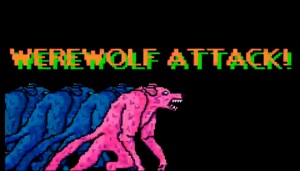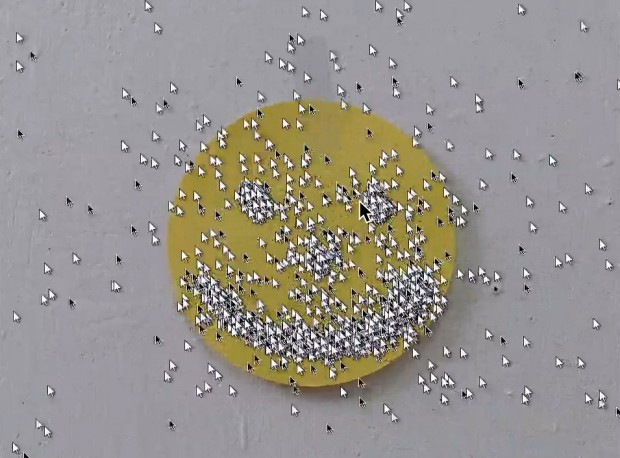Indie Rock: Music Video Games
- Updated: 17th Apr, 2013
Do Not Touch
We’re a privileged few that get to experience Do Not Touch before it’s inevitably filled up entirely with the inputs of other cursors and we can’t see the video at all anymore. That’s sort of what happens when a cool thing suddenly emerges and everyone finds out about it: Within a week it’s ruined. Do Not Touch is going to be the Massive Interactive Music Video version of someone doing a Borat impression in a Let’s Play video for Portal.
Right now, though? It’s at a decent sweet-spot where there’s enough noise on screen, but it’s mostly all functioning as intended. The purpose of the webpage is that it records your mouse cursor’s placement throughout the course of a music video and then adds it to a growing number already present. The video offers specific instructions that you can choose to obey or disobey if you feel like it. This interactivity is key to the song, which contains lovely references to about going against the grain and such, so even when there’s people deliberately not doing what they’re told it’s still fitting and appropriate. The activities are cool, not to spoil too much, it’s interesting how users have interpreted the instructions and displayed their willingness to play along.
It’s thankfully difficult to deliberately grief on a single-person scale (what’re you gonna do? just hang out in one spot?) the real problem will start when people start organising and working to cover the screen in meticulously purposeful nonsense. Get in and play it quick before the internet starts to unionise. It’s What Former Prime Minister Margaret Thatcher Would Want Topical Reference.
This isn’t a new idea, music videos that are interactive I mean, not music in general (you probably should have come across the concept of music already even if you’ve never heard it). There’s a couple of games already that serve as counterparts to songs. They’re nowhere near as massive, nor part of a social experiment, but if you like the idea of interaction being a fun addition to what you’re hearing then here’s two other recommendations:
PUNKSNOTDEAD
 I think it’s great that the .exe for this game is titled “get-punched” dispite the game having an entirely different title. It’s probably more accurate for everything contained within. There’s the gameplay (punch based), the lyrics of the song and just about the entire sensation you feel from booting it up; PUNKSNOTDEAD is the videogame equivalent of a random clock to the head from a moving vehicle that then speeds off and crashes. The actual title’s fitting enough, but really, this is the game where you punch people. People get punched. If you get shot you’re sent right back to the start of the game (because whatever) and the song’s adaptive loop begins at the first part again.
I think it’s great that the .exe for this game is titled “get-punched” dispite the game having an entirely different title. It’s probably more accurate for everything contained within. There’s the gameplay (punch based), the lyrics of the song and just about the entire sensation you feel from booting it up; PUNKSNOTDEAD is the videogame equivalent of a random clock to the head from a moving vehicle that then speeds off and crashes. The actual title’s fitting enough, but really, this is the game where you punch people. People get punched. If you get shot you’re sent right back to the start of the game (because whatever) and the song’s adaptive loop begins at the first part again.
That last part’s annoying but, y’know, it’s punk. Whoever made it probably did so in a single day. Shut up. It’s cool. Don’t think too hard. Get Punched.
Keyboard Drumset Fucking Werewolf
Picture the scene: It’s 2012. A handsome, charming video game writer and his colleague are at Eurogamer’s Rezzed event in sunny coastal Brighton, hub of British alternative culture, viewing the upcoming stars of Indie and PC-focused video game development. They stumble on Hotline Miami at its own booth and, having not heard anything about it, all they can keep saying to each other is “This is great, who’s this by? Is this by the Keyboard Drumset Fucking Werewolf guy?”
 Imagine a world where this conversation is possible. I know that it is. I lived it. I’m the guy from the story. The handsome and charming one. Gasp.
Imagine a world where this conversation is possible. I know that it is. I lived it. I’m the guy from the story. The handsome and charming one. Gasp.
So yes: it turns out it was. Both Hotline Miami and KDFW can be partially attributed to (blamed on?) Jonatan Söderström AKA Cactus. In a way you can view a lot of what Werewolf achieves as something of a Proto-Hotline. There’s similar use of colour and character designs, great music choice, ultra-violence. The only difference is in Hotline you’re barely a Werewolf at all. You’re basically half that. You’re Full-Were.
What’s interesting about KDFW is that the song goes through different moods and structures and the mechanics change with it. It’s all simply controlled, but you’re switching from a platformer to avoiding obstacles to… ach, play it. This Video Game Is A Good One.


Follow Us!